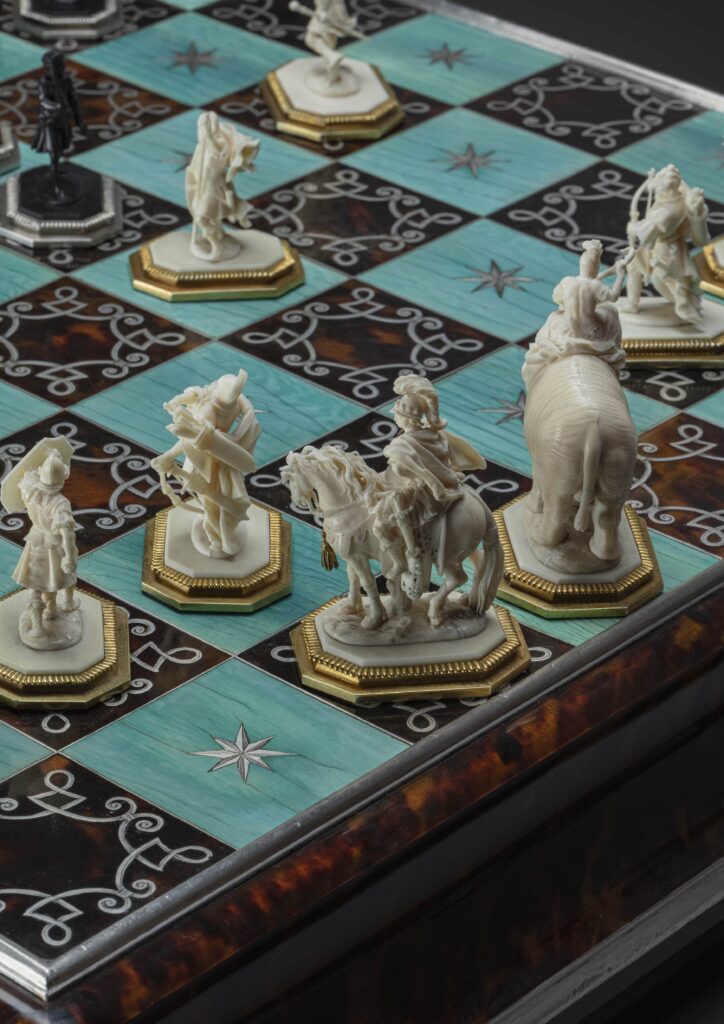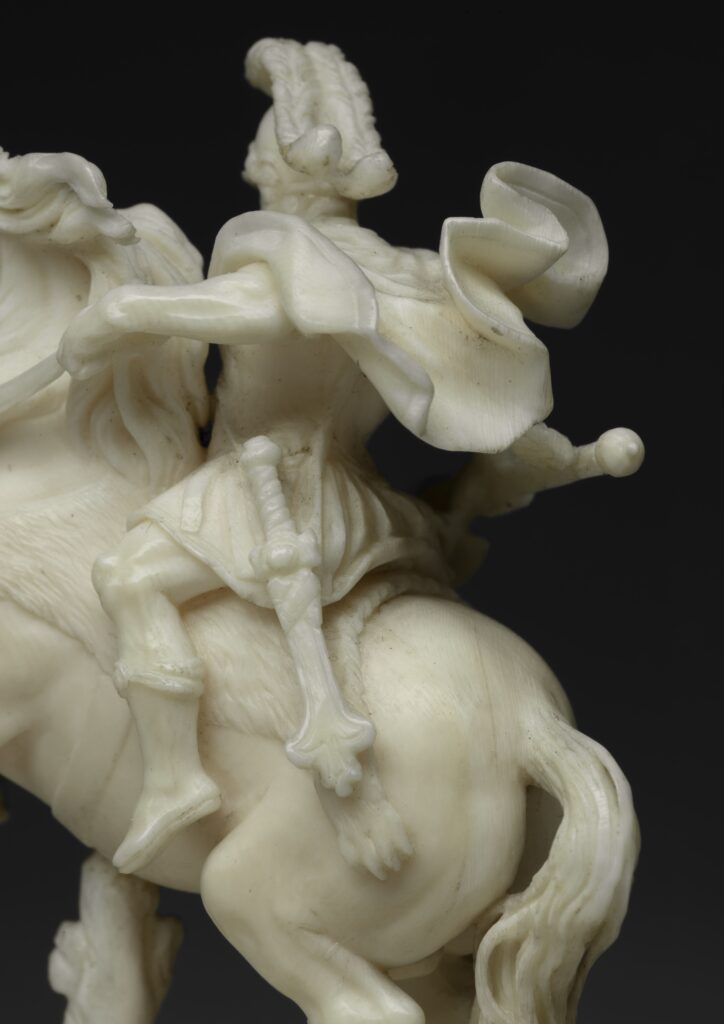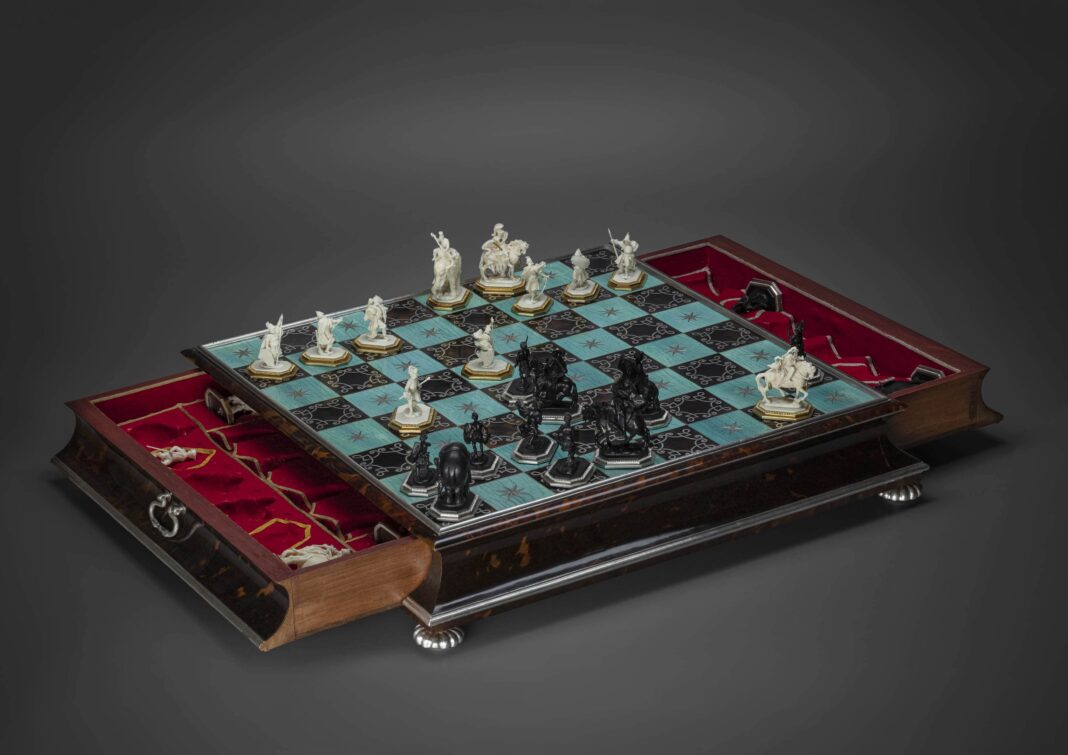On the occasion of its 300th birthday, the Grünes Gewölbe receives a precious addition from the Ernst von Siemens Art Foundation: a magnificent chess made of ivory, ebony, tortoise shell and silver from the time of the museum’s founder, Augustus the Strong.
Fig. above: Grünes Gewölbe – Paul Heermann, Dresden c. 1705, board casket by Paul Solanier, Augsburg, c. 1705-1709- Guillaume Benoit © Galerie Kugel, Paris
The Augsburg chess set with pieces attributed to the Saxon sculptor Paul Heermann (1673-1732) is one of the spectacular new discoveries of recent years in the field of European Baroque treasure art. After having been in private hands for centuries, the chess set surfaced on the art market in 2018. Thanks to the Ernst von Siemens Art Foundation, it has now been acquired for the Grünes Gewölbes.
In terms of material and artistic workmanship, it is a showpiece that has no known equivalent. The 32 chess pieces of a maximum height of eight centimetres are masterfully carved miniatures. Each one is individually realised and comes together to form an ensemble of the highest suggestive power. The pieces represent “European” and “African-Oriental” dressed persons, with the pawns rendered as soldiers and the bishops as heralds. The use of war elephants on both sides suggests a reference to the Syrian Wars (192/188 BC), in which the Romans were victorious over the Seleucid forces.
In doing so, the sculptor skilfully used the processing quality given by the different hardness and structure of ivory and ebony to give the white and black opponents their specific expressiveness. Ethnographic-historical correctness played a subordinate role here; what was important was the dualistic juxtaposition of two different groups characterised as individual people from European and non-European cultures.

The game board is also distinguished by its high artistic quality. The fact that it was created especially for the figures is evidenced by the precisely fitting gilded silver bases. Their hallmarks and master marks refer to the Augsburg goldsmith Paul Solanier (1635-1724). The silver inlays of the playing fields – stars in green dyed ivory and intertwined Régence frames in tortoise shell – were also created in his workshop. Tortoiseshell was also used to veneer the fluted sides of the high board, which is equipped with two drawers facing each other. The inserts contained recesses for each figure, so that the board also functions as a casket for the sculptural treasures.
The hardly legible inscription on the messenger slip of one of the white herald bishops bears the inscription “Her/mann” executed with a hot needle in microprint. If this detail, which is barely visible to the naked eye, can indeed be read as a reference to the creator of the pieces, it would be the only baroque chess set with such a signature known to date. In fact, the figures are stylistically and compositionally close to works that are secured for or attributed to Paul Heermann – a sought-after sculptor in Saxony, collaborator and probably also competitor of Balthasar Permoser (1651-1732) and finally court sculptor.
For Dresden court art in the late 17th and early 18th centuries, connections to Augsburg and collaboration with goldsmiths there played a central role. This is exemplified by the Jupiter Column in the Grünes Gewölbes, for which Balthasar Permoser created the ivory group and Johann Andreas Thelot the silver reliefs on the column’s base, which, like the chess set, is covered with tortoiseshell and partly coloured green. The chess set not only represents characteristic traits of Saxon court art of the early Augustan period, but is also evidence of supra-regional cooperation in the field of treasure art. The merchants of the southern German goldsmith’s metropolis were in continuous contact with the Saxon court, were present at the Leipzig fairs and maintained the best trade relations with Dresden, which ultimately made the creation of a complex work such as the present chess set possible.
Although the work itself gives no direct indication of an addressee, the precious materials and the artistic standard leave no doubt that it was a courtly cabinet piece reserved for a princely environment.

Marius Winzeler, Director of the Grünes Gewölbe and the Armoury: “With the acquisition for the Grünes Gewölbes, the chess set receives an ideal collection context and also closes a sensitive gap: according to Baroque inventories, at least three comparable chess sets belonged to the Dresden collection but were lost. In addition, the exquisite miniature sculptures find an environment in the Green Vault’s inventory of ivory statuettes that allows for fascinating comparisons for the public and new insights for research.”
Martin Hoernes, Secretary General of the Ernst von Siemens Art Foundation: “For the Grünes Gewölbes’ birthday celebration, there can only be one unique gift from the Ernst von Siemens Art Foundation that was already expensive at the time of its creation: A “royal” chess set, a luxury object made of the most precious materials and produced with the highest craftsmanship. The new showpiece is not only a feast for the eyes of the visitors, but also contains research tasks for the curators: Can the black and white micro-sculptures be integrated into the work of the Dresden sculptor Paul Heermann? Who was the original owner of the cimelia?
In future, the chess set will be exhibited in the New Grünes Gewölbes of the Dresden Residence Palace and presented together with comparable masterpieces from the collection of Augustus the Strong in the Dinglinger Hall.
Provenance: Probably in the possession of the von Münch banking family since the 18th century; until 1920 Otto von Münch, Schloss Hohenmühringen; subsequently owned by the von Podewils descendant family; auctioned at Christie’s, London, in 2018; since then Galerie Kugel, Paris.
WHERE?
Grünes Gewölbe
in the Residenzschloss
Taschenberg 2
01067 Dresden






